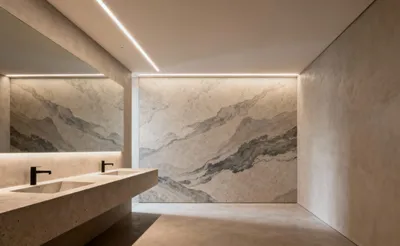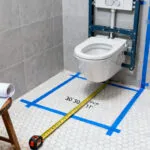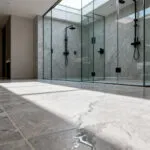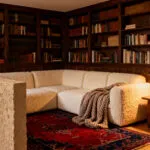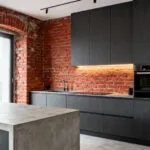Designing a home is fundamentally an act of self-revelation—every choice reflects not just aesthetic preference, but deeper values about how life should be lived. The most compelling interiors aren’t decorated; they’re authored. They tell coherent stories about their inhabitants’ journeys, aspirations, and understanding of beauty’s role in daily life. And nowhere is this authorship more critical than in the bathroom, our most private and ritualistic space.
The walls that enclose this sanctuary are more than just boundaries. They are canvases for sensory experience, engineered surfaces that interact with light, sound, moisture, and touch. To choose a bathroom wall decoration is to make a statement about endurance, wellness, and the kind of beauty you want to engage with every single day. These twenty strategies separate spaces that feel authentic and resonant from those that simply look styled for a fleeting moment. We will move from foundational concepts to specific material science, turning this intimate room into a masterful composition of form and function.
Cultivating the Ephemeral: Foundations of Transcendent Bathroom Aesthetics (Part 1)
Before a single tile is chosen, we must start with the intangible. A truly exceptional space is born from a clear vision—an understanding of the desired feeling, the intended ritual, and the story the room is meant to tell. This is about establishing the core narrative that will guide every material decision to follow.
1. Deconstruct the Archetype: Visioning the Bespoke Sensory Experience
We begin by forgetting what a bathroom is supposed to be. Is it merely a place for hygiene, or is it a chamber for decompression? A vibrant space to energize the morning, or a quiet grotto for evening contemplation? The first step is to define the sensory experience you want to cultivate. Think beyond visuals—consider acoustics, the feel of a surface under your fingertips, and how light, both natural and artificial, will play across the walls throughout the day.
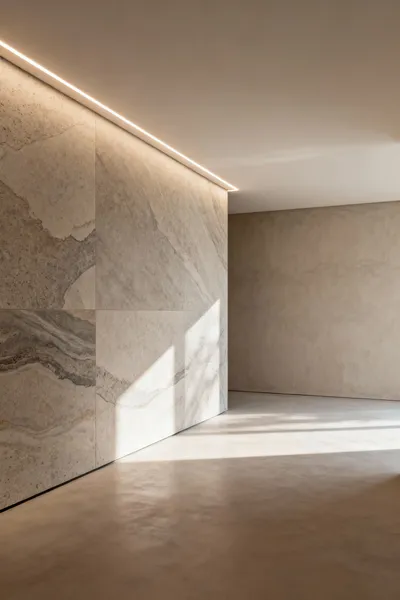
This mindset transforms material selection into an act of sensory alchemy. Instead of just choosing a tile, you’re choosing a sound profile. A wall of dense, large-format porcelain will create a quiet, solid enclosure, while a wall of smaller, hand-glazed zellige tiles will scatter light and sound with a lively, vibrational quality. From my own work in surface design, I’ve learned that a material’s haptic feedback is as crucial as its color. The cool, waxy touch of Tadelakt plaster communicates something entirely different from the grounded, porous feel of terracotta. The question evolves from “What looks right?” to “What combination of sensations will support my daily rituals?”
2. Master the Hermeneutics of Space: Decoding Architectural Narratives for Wall Enhancement
Every room has a story, told through its proportions, its light, and its existing architectural language. The most profound design works with this narrative, not against it. Before you impose a new idea, become an interpreter of the space. Does it have high ceilings that ask to be celebrated? An awkward corner that could become an intimate, intentional niche? The walls are not blank slates; they are part of a larger conversation.
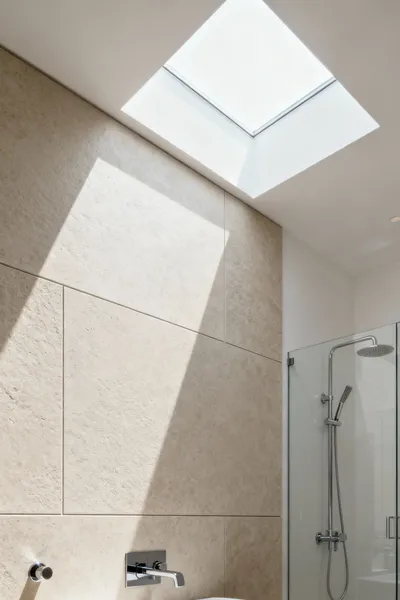
Your material choices should become the next chapter in this story. A bathroom in a historic brownstone might whisper for walls of limewash or classic wainscoting that honors its heritage, while a modern condo with vast windows might call for vast, seamless panels of microcement that speak to its minimalist bones. You’re not decorating; you’re continuing an architectural dialogue, choosing surfaces that feel inevitable and authentic to the structure itself.
3. The Art of Curated Disruption: Integrating Contrasting Elements for Dynamic Visual Cadence
Perfect harmony can be, frankly, a little dull. A space truly comes alive through moments of curated disruption—a calculated tension between opposing forces. This is the art of balancing serenity with a jolt of energy. Think of a raw, unfinished concrete wall meeting a panel of immaculately polished, back-lit onyx. The friction between the two makes each material’s inherent character sing more clearly.

On the bathroom wall, this can manifest as a single, intensely textured element against three otherwise smooth, quiet surfaces. I once designed a space where a wall of shimmering, iridescent mosaic tile—like the inside of an abalone shell—was set against walls of soft, matte grey plaster. The mosaic became a piece of kinetic art, its character amplified by the restraint of its surroundings. This is about creating a focal point that doesn’t just draw the eye, but energizes the entire room with its calculated contrast.
4. Symphony of Subtlety: Orchestrating Visual Harmony Through Muted Tones and Nuanced Textures
The opposite of disruption, and equally powerful, is the symphony of subtlety. This is design that whispers, creating a profound sense of calm through a tightly controlled palette of muted tones and closely related textures. It’s an approach that demands incredible precision, as the interest comes from the delicate interplay of surfaces, not from bold statements.

Here, the focus is on materials whose beauty is revealed upon closer inspection. Think of a limewash paint with its soft, cloud-like variations, a wall of linen-textured porcelain tiles, or the subtle luminosity of Venetian plaster. By layering these nuanced textures within the same color family, you build visual complexity without creating noise. Light becomes your primary tool, raking across a delicately ribbed wall panel or catching the gentle sheen of a matte surface, creating a space that feels expansive, serene, and deeply luxurious in its restraint.
Cultivating the Ephemeral: Foundations of Transcendent Bathroom Aesthetics (Part 2)
With a narrative established, we turn to the human element. How does the body perceive and interact with the space? A successful design feels intuitively right because it is calibrated to our own scale and senses, making the architectural feel personal and resonant.
5. Anthropometric Proportions: Calibrating Wall Embellishments to Human Scale and Perception
A design can feature the most exquisite materials in the world, but if the scale is off, the space will feel fundamentally wrong. Anthropometrics—the science of human measurement—is the invisible force behind comfortable, intuitive design. A decorative tile band placed at the perfect eye-level height creates a pleasing horizon line. A shower niche is positioned for an easy, unconscious reach. These aren’t accidents; they’re decisions calibrated to the human form.
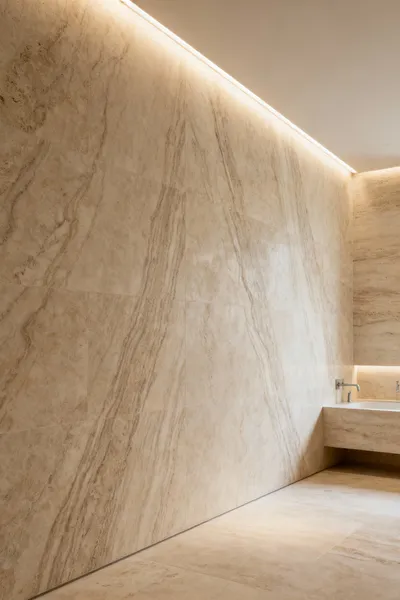
This principle directly governs your bathroom wall decoration. In a powder room, a delicate, small-scale wallpaper pattern can create an intimate, jewel-box effect that a large, sweeping pattern would overwhelm. In a grand primary bath, using oversized slabs of stone minimizes grout lines and creates a sense of monolithic calm that respects the large volume. What I always emphasize is that you’re designing for a body in motion. Think about where the eye naturally falls when standing at the vanity, or the texture your shoulder might brush against in the shower. Every choice should feel like a handshake between the architecture and the occupant.
Material Semiotics: Engineering Sensory Immersion Through Advanced Surface Interventions (Part 1)
Materials are a language. They communicate ideas—of strength, of softness, of heritage, of modernity. Here, we delve into the specific science and artistry of advanced surface materials, understanding not just what they look like, but what they do and what they say.
6. Porcelain Stoneware Phenom: Leveraging the Non-Porous Versatility of Technical Ceramics
Let’s start with the undisputed workhorse of the modern bathroom: porcelain stoneware. This isn’t your grandmother’s ceramic tile. It’s a technical marvel, born of refined clays and minerals fused under immense heat and pressure in a process called vitrification. The result is a material with a water absorption rate of less than 0.5%, making it virtually impervious to water, staining, and bacteria. It’s the very definition of a high-performance surface.
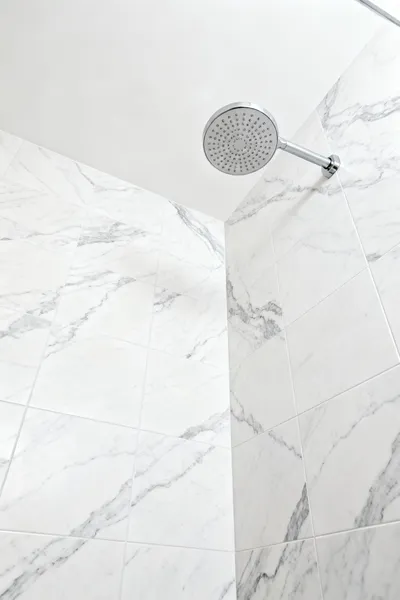
But its true genius lies in its aesthetic versatility. Digital printing technology now allows porcelain to convincingly replicate anything from rare Calacatta marble to raw concrete to warm, rift-sawn oak—all while offering indestructible performance. Using large-format porcelain slabs for your bathroom walls can create a stunning, near-seamless look that delivers the visual impact of natural stone without the maintenance headache. It is the perfect marriage of informed science and inspired aesthetics.
7. The Tactility of Tadelakt: Mastering Moroccan Lime Plaster for Seamless, Breathable Surfaces
If porcelain is the product of modern engineering, Tadelakt is the soul of ancient craft. This traditional Moroccan lime plaster offers something entirely different: a seamless, breathing surface with a unique, sensual tactility. Applied in thin layers and meticulously burnished with a river stone, the plaster is then sealed with an olive oil soap. This creates a chemical reaction—saponification—that makes the lime itself naturally waterproof. No grout, no seams, just one continuous, flowing surface.
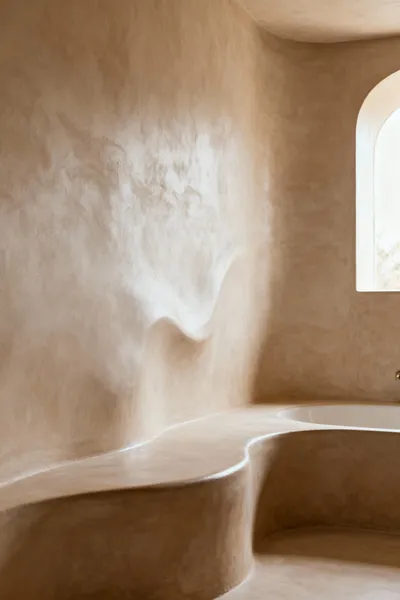
The beauty of Tadelakt is in its subtle imperfections and its living quality. Its surface is not flat but undulates gently, playing with light in a way that feels organic and alive. I’ve noticed in my work with material combinations that people are irresistibly drawn to touch it; it has a cool, waxy, soapstone-like feel. Furthermore, its high alkalinity makes it naturally anti-fungal, contributing to a healthier indoor environment. To choose Tadelakt is to choose a piece of history and artistry for your walls.
8. Engineered Wood Composites: Exploring Moisture-Resistant Panel Systems for Warmth and Acoustic Attenuation
Bringing wood into a bathroom used to be a risky proposition. Today, engineered wood composites offer a brilliant solution. We’re talking about high-density fiberboard (HDF) with moisture-retardant resins or panels with marine-grade cores, finished with incredibly realistic veneers or laminates. These materials are specifically designed for dimensional stability in humid environments, resisting the warping and swelling that plague solid wood.
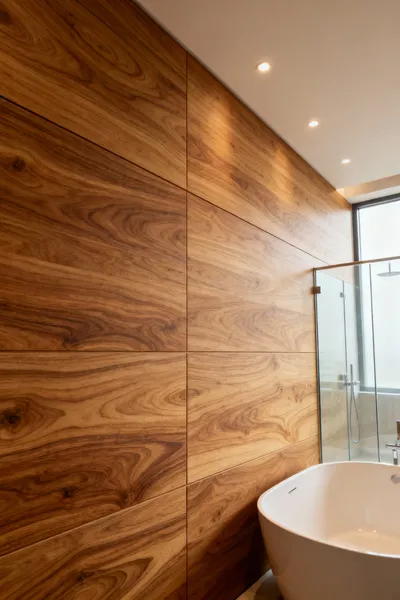
Beyond aesthetics, these panel systems introduce two often-overlooked luxuries: warmth and acoustic comfort. Wood has a psychologically warming effect that provides a beautiful counterpoint to the cool hardness of tile and stone. More scientifically, its fibrous structure helps absorb sound, dampening the harsh reverberations common in bathrooms. A slatted wood feature wall behind a vanity doesn’t just look stunning—it subtly softens the room’s acoustics, turning a functional space into a more serene sanctuary.
9. Stratifying Metallics: Integrating Anodized Aluminum and Patinated Copper for Reflective Depth and Antimicrobial Properties
Metals introduce a dynamic, light-catching quality to bathroom walls. But the most interesting applications go beyond a simple polished chrome fixture. Consider the sophisticated potential of anodized aluminum and patinated copper. Anodizing creates an incredibly durable, corrosion-resistant oxide layer on aluminum that can be imbued with a range of deep, permanent colors, from matte black to champagne bronze. It offers a sleek, precise, and modern finish.
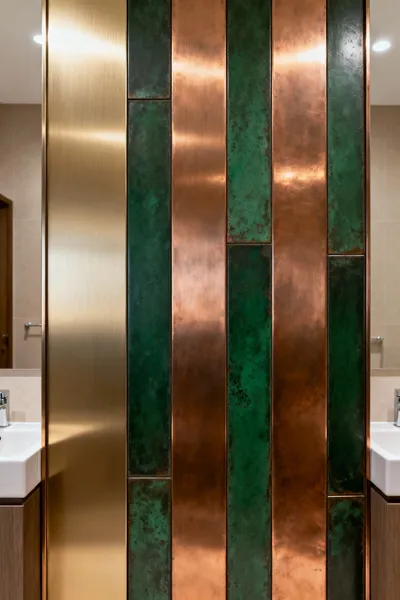
Copper, on the other hand, is a living metal. It possesses natural antimicrobial properties, actively killing bacteria on its surface—a significant benefit in a bathroom. But its real allure is its tendency to develop a patina over time, shifting from a bright luster to deep, rich browns and verdigris greens. What I find so compelling is the ability to layer these two—perhaps using precise panels of anodized aluminum to frame a richly patinated copper sheet. You get a fascinating dialogue between the new and the old, the stable and the evolving, right on your wall.
Material Semiotics: Engineering Sensory Immersion Through Advanced Surface Interventions (Part 2)
Continuing our material exploration, we look at surfaces that redefine spatial boundaries. These choices are about creating a sense of monolithic cohesion, sculpting with light, and inviting the restorative power of nature directly into the room’s architecture.
10. The Resinous Canvas: Employing Microcement and Epoxy Finishes for Monolithic Visual Cohesion
The enemy of a serene, expansive feeling in a small bathroom is the grout line. Resinous finishes like microcement and epoxy offer the ultimate solution: the monolithic surface. Microcement is a polymer-modified cementitious coating applied by hand in thin layers, creating a continuous, waterproof skin over walls, floors, and even countertops. The result is a seamless, architectural finish with a beautiful, subtle texture.
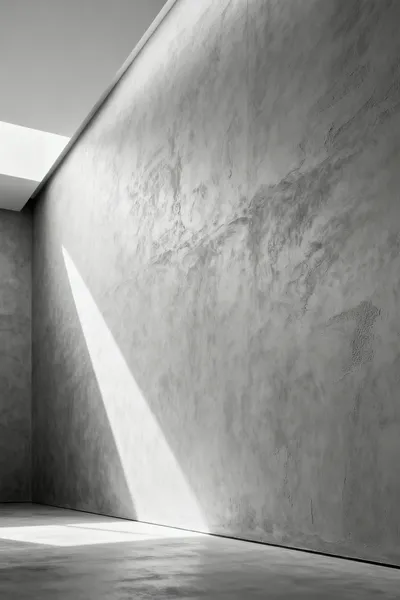
Epoxy offers a harder, higher-gloss alternative, often used for its durability and vibrant color possibilities. By wrapping one of these materials from the floor up onto the walls of a shower, you completely dissolve the traditional boundaries of the space. This visual continuity makes any room feel larger and more cohesive. From my professional experience, this approach is the key to achieving a high-end, spa-like atmosphere where the architecture itself feels sculpted and whole.
11. Glass Block Artistry: Sculpting Light and Privacy Through Translucent Architectural Elements
Glass block is back, but not in the way you remember it. Modern iterations offer a stunning array of textures—wavy, frosted, reeded—that transform this structural element into a tool for sculpting light. A wall of carefully chosen glass block can borrow light from an adjacent room or the outdoors while maintaining total privacy. It becomes a source of diffuse, ethereal illumination that changes throughout the day.

Think of a walk-in shower where one wall is composed entirely of reeded glass blocks. You get privacy, but also a beautiful play of light and shadow that makes the enclosure feel open and airy, not confined. This is a brilliant way to solve practical design problems—like a windowless bathroom—with an elegant, architectural solution that feels intentional and artistic.
12. Biophilic Reconnection: Incorporating Stabilized Moss Walls and Hydroponic Panels for Natural Integration
Biophilia—our innate need to connect with nature—is a powerful force in design. Bringing living or preserved botanicals directly onto the walls is the ultimate expression of this principle. Stabilized moss walls are a fantastic, zero-maintenance option. The moss is real, but it has been preserved to retain its soft texture and vibrant color without needing water or light. It’s a stunning way to add a swath of intense, natural green and has the added benefit of being an excellent sound absorber.
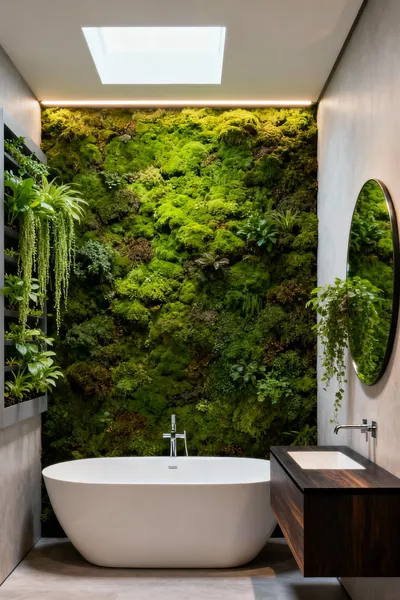
For a truly living installation, hydroponic wall panels allow for a vertical garden of humidity-loving plants like ferns and pothos. While this requires more technical integration for irrigation and lighting, the reward is a dynamic, air-purifying piece of natural art. A moss panel behind a freestanding tub or a living wall in a light-filled bathroom doesn’t just decorate the space—it fundamentally changes its character, transforming it into a restorative oasis.
Proximal Ornamentation: Executing Intentional Design on Constrained and Expansive Vertical Planes
With our materials chosen, we now focus on composition. This is about the strategic placement of elements on the vertical plane—the walls—to guide the eye, manipulate the perception of space, and create a balanced and compelling interior landscape.
13. Curating the Focal Vestibule: Architecting Visual Gravity with Feature Wall Segmentation
Not every wall can be the star. Effective design relies on hierarchy. By designating a single feature wall—typically the one behind the vanity or tub—you create visual gravity. This anchors the room and gives the eye a place to rest. This wall becomes a concentrated moment of beauty and materiality, allowing the other walls to be quiet supporters.
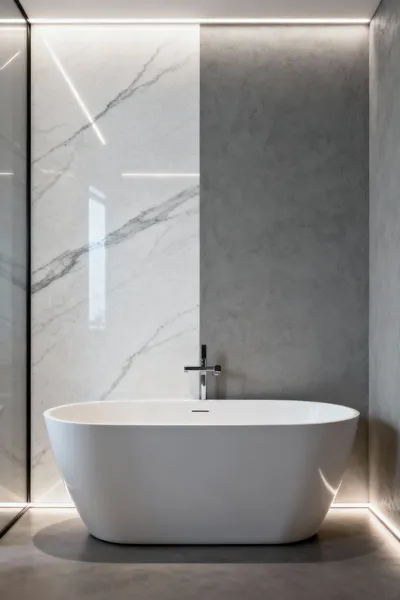
This is where you can invest in a truly spectacular material. A full-height, book-matched slab of marble where the veins create a stunning natural mural. A wall of intricately carved wooden panels. Or a surface of deeply textured, metallic-flecked wallpaper. I learned this when working on a very long, narrow bathroom; by cladding the short back wall in a dramatic, dark stone, we created a powerful focal point that visually foreshortened the room, making its proportions feel more balanced and intentional.
14. The Illusion of Expansion: Employing Strategic Mirror Placement for Perceived Volume Amplification
Mirrors are the oldest trick in the book for a reason. They don’t just reflect an image; they reflect light and space, literally doubling the perceived volume of a room. But strategic placement is key. Placing a large mirror on the wall opposite a window is the most powerful move, as it brings the outdoors in and floods the room with natural light.
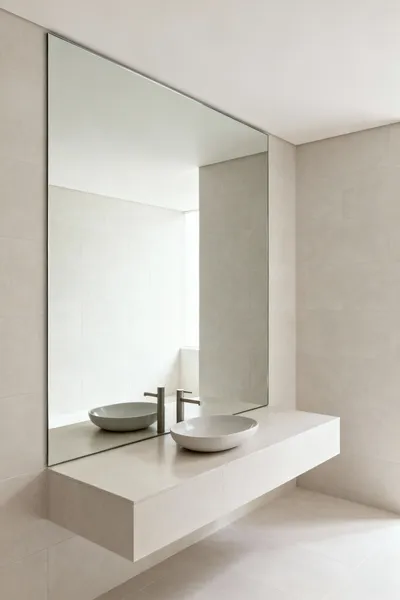
Go beyond a simple vanity mirror. Consider cladding an entire wall, from floor to ceiling, in mirrored panels. In a small powder room, this can create a dazzling, almost infinite effect that completely dissolves the room’s tight boundaries. Using antiqued or smoked mirror finishes can add a layer of sophistication, offering a softer, more atmospheric reflection than standard silvered glass.
15. Recessed Illumination as Art: Integrating Ambient and Task Lighting Within Wall Cavities
Light should be a material, not just a fixture. By integrating lighting directly into the architecture of the walls, you create a seamless and sophisticated effect. This is about building light into recessed niches, coves, and vertical channels, so the source of the glow is hidden, and the light itself becomes the feature.
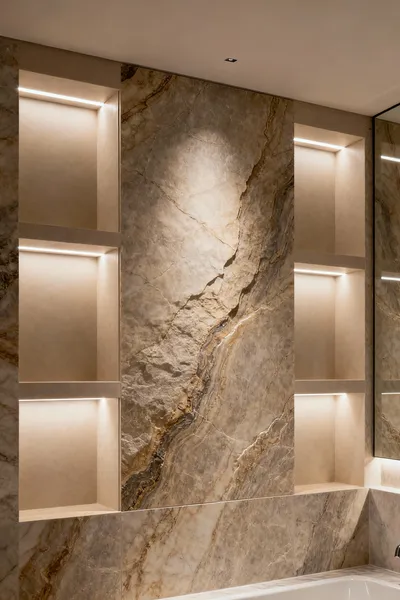
Imagine a soft, linear glow washing down a textured stone wall from a hidden cove near the ceiling. Or a shower niche that is lit from within, turning everyday toiletries into a beautifully illuminated display. For task lighting, integrating vertical LED strips into the wall on either side of a vanity mirror provides perfectly even, shadow-free light for grooming. This approach elevates lighting from a functional necessity to an integral, sculptural element of the wall design itself.
16. The Vertiginous Garden: Cultivating Micro-Landscapes Through Suspended Planter Systems and Living Art Installations
Where a full living wall isn’t feasible, suspended systems offer a more delicate approach to biophilia. Think of this as creating a “vertiginous garden.” Instead of placing a single pot on the floor, consider a series of elegant, wall-mounted planters or a suspended rail system from which curated botanicals can hang.
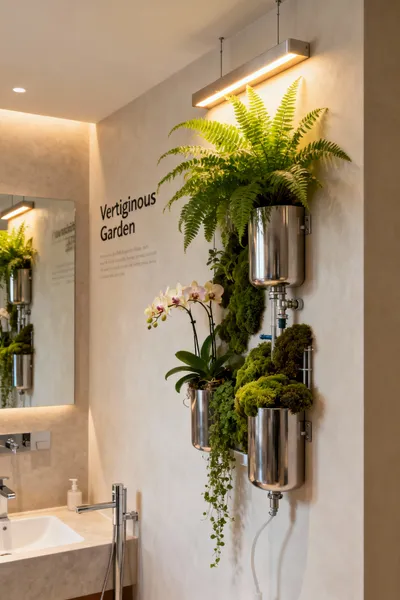
This turns plants into living sculpture, drawing the eye upward and adding a layer of dynamic, organic texture against the static architecture of the wall. Using trailing plants like string-of-pearls or ivy can create beautiful green cascades. It’s a way to incorporate nature with a light, architectural touch, treating each plant as a considered element within a larger vertical composition.
Adaptive Environments: Future-Proofing Wall Decor for Longevity and Evolving Sensibilities
Finally, great design isn’t just for today; it’s for tomorrow. This is about making choices that are durable, adaptable, and timeless, creating a space that will endure both physically and aesthetically. It’s the ultimate expression of value-driven design.
17. Anticipatory Maintenance Regimens: Selecting Finishes with Intrinsic Longevity and Ease of Upkeep
The most luxurious material is one you don’t have to worry about. Future-proofing starts with selecting materials designed for longevity and simple upkeep. Large-format porcelain or sintered stone slabs with epoxy grout are champions here. The near-total lack of porous grout lines means there’s nowhere for mold and mildew to take hold, making cleaning effortless.
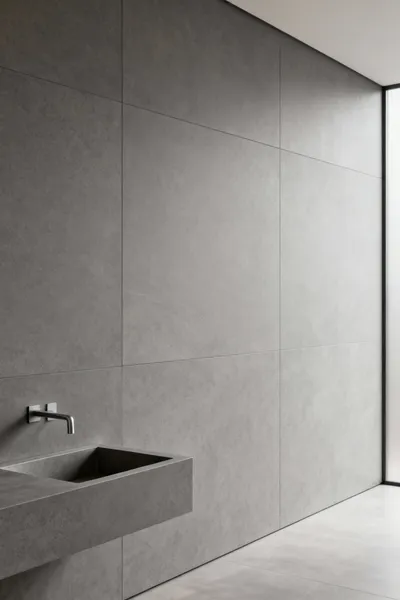
Back-painted glass panels offer another brilliant solution for shower walls or backsplashes. They provide a completely seamless, non-porous surface that can be wiped clean in seconds. This philosophy of “anticipatory maintenance” isn’t about laziness; it’s about intelligent design that respects your time and preserves the beauty of your investment for decades to come, ensuring the space looks as pristine in year ten as it did on day one.
18. Thermodynamic Harmony: Utilizing Wall Materials to Regulate Humidity and Thermal Comfort
Walls can do more than just stand there—they can be active participants in creating a comfortable microclimate. Materials with hygroscopic properties, like natural lime plasters (including Tadelakt) or certain clay finishes, have the incredible ability to absorb excess moisture from the air during a steamy shower and then slowly release it back as the room dries out. This acts as a natural dehumidifier.
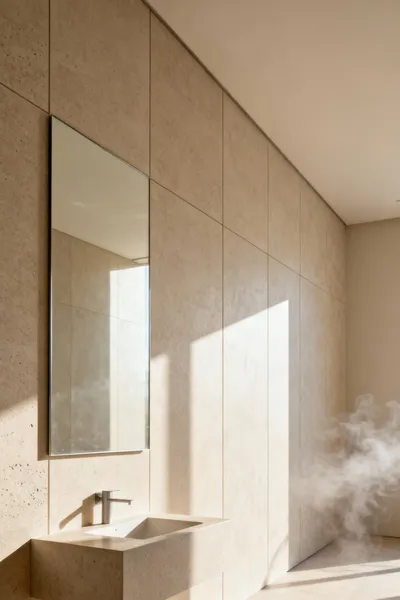
Furthermore, materials with high thermal mass, like thick stone or concrete, can help regulate temperature. They absorb warmth and radiate it back slowly, tempering sharp temperature swings and making the space feel more consistently comfortable. This is a subtle, yet deeply effective, way of using material science to enhance the visceral experience and energy efficiency of the bathroom.
19. Acoustic Attenuation Design: Mitigating Reverberation Through Strategically Placed Soft Textures and Absorptive Panels
We’ve touched on acoustics, but it deserves its own point. A bathroom full of hard surfaces can be an echo chamber. Deliberately designing for sound absorption is a mark of true luxury. This doesn’t mean you have to carpet the walls. It’s about strategic interventions.
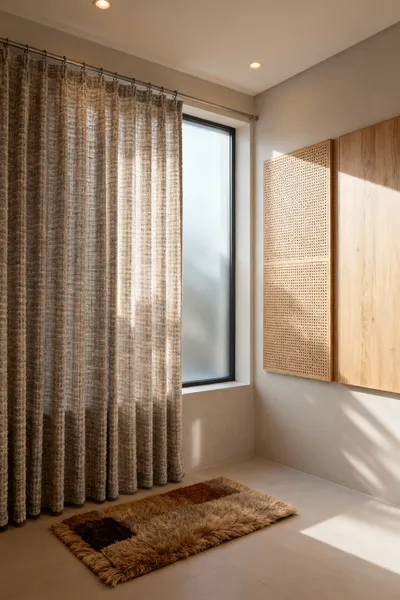
Incorporate moisture-resistant acoustic panels wrapped in fabric on a wall outside the main splash zone. Use perforated or slatted wood panels, which allow sound to pass through to an absorptive layer behind them. Even thinking about where you will hang your plush, thick towels on the wall can be an acoustic strategy. Quieting a space allows the soothing sound of water to take center stage, transforming the room’s sonic character from harsh to serene.
20. Ephemeral Artistry: Designing for Seasonal Reinvigoration with Rotational Textile Panels and Demountable Installations
The final frontier of adaptive design is creating a space that can evolve with you. This involves designing a permanent, durable “stage” and then layering in elements that can be easily changed. Think of a feature wall designed with an integrated, concealed track system or magnetic panels.
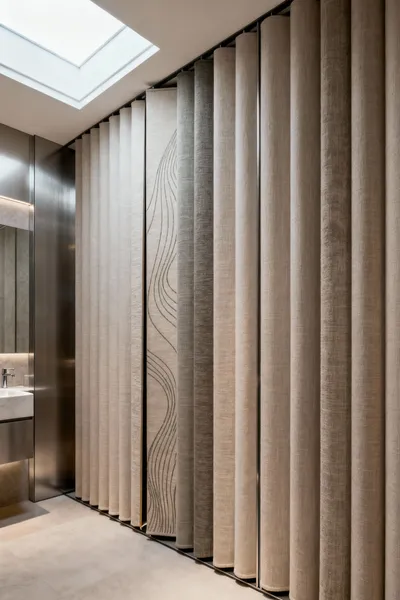
This allows you to swap out art, textile panels, or thin decorative finishes with the seasons or as your taste changes, without undergoing a major renovation. You could have a vibrant, floral textile wall for spring and a deep, richly textured wool panel for winter. This approach separates the permanent architecture from the ephemeral decoration, ensuring your space feels both timeless and personally relevant for years to come.
Conclusion
Our journey through these twenty strategies reveals a single, powerful truth: the walls of your bathroom are not merely surfaces to be covered, but opportunities to be authored. We have moved past the simple idea of decoration to embrace a more profound understanding of materiality, sensory experience, and enduring design. You are now equipped to make choices that are not only beautiful but also intelligent, resonant, and deeply personal.
As you approach your own space, do so with confidence. Trust your intuition, but back it with an understanding of how materials perform and communicate. Create a dialogue between texture and light, permanence and adaptability, science and soul. The goal is to craft a sanctuary that goes beyond function to provide genuine moments of restoration and delight. Let the walls of your bathroom tell a story—your story—of a life lived with intention and a deep appreciation for enduring beauty.
